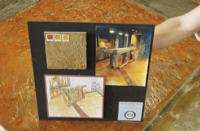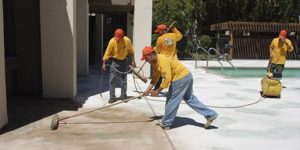Some things in life a person can bluff their way through but, unfortunately, decorative concrete is not one. I found this out the hard way early on in my career when a customer from the previous year called asking to add more decorative stamping. She said they loved the work previously installed, and now she wanted to add a pool deck to match the patio right down to the colors and pattern. No problem, right? Wrong.
In my haste, I had committed one of the biggest decorative sins in the business. I didn’t record the color hardener, release colors or mix design I had used to create what she wanted more of.
This life lesson taught me something that has led to hundreds of thousands of dollars of new work over the years.
All decorative contractors must store accurate records in order to accomplish two things.
First, you will be able to confidently match old work when a customer calls with new work. Remember, guys, the best source for new work is past customers who already know and trust your business.
Second, you will be able to prove proper materials or techniques were used at the time of placement, installation and protection — according to real-time weather and job conditions.
Concrete artisans now have more product choices and better training than ever before. But with an increasing number of manufacturers comes a problem that few who use multiple suppliers or manufacturers consider. Product compatibility, or lack of, often contributes to a failed decorative project.
When this happens, the contractor usually blames the manufacturer and the manufacturer blames the contractor. Unfortunately, in these circumstances, the customer and decorative industry have the most to lose, and only because of a lack of recordkeeping and accountability.
Accurately recording color ratios and mixes will help eliminate product compatibility mistakes. A crew keeping good records usually follows the manufacturers’ installation instructions closely. It is hard to argue that a crew taking time to record project data cut corners during installation or chanced incompatibility.
How to get started
The suggestions I’m making today need not be viewed as complex or time-consuming. Accurate record-keeping should be considered just as necessary as color, sealer or labor, since recording job-specific items and procedures is no longer optional.
Accounting software programs such as Intuit QuickBooks are no longer limited to creating invoices or tracking sales. You can integrate your bookkeeping system by adding job-specific items, including colors, patterns, sealers, stains and so on along with typical accounting information.
If computer-based record-keeping isn’t for you, create an old-fashioned paper form that covers all job-specific items. Make a few dozen copies and use this form to record everything job-specific for each project. This simple system has saved my firm countless hours searching for information or just guessing colors, patterns and seal dates.
I recommended you create a job file (either on computer or paper) that includes the following information:
Accurately list customer, contractor and project name along with contact information.
Record job-site sample colors, materials used, and the date the sample was installed.
Keep a record of all submittals and job-related correspondence.
Log information when requesting underground utility locates.
Record estimated start date, delays and work progression.
Record the ambient temperature or anything unusual that could affect quality.
Record date of installation, decorative detailing and sealing.
Take photos that prove the job was well-protected, barricaded, or taped off with caution tape.
Compare the actual colors and patterns to the original plan, and record all changes.
Most importantly, record all change orders. Don’t forget to have all change order agreements signed prior to installation.
Detail, copy and share a maintenance plan along with a list of information the customer could find helpful.
Monetary benefits
Business-minded individuals easily equate a new tool with increased profit but can have difficulty wrapping their minds around practices like record-keeping that offer the same monetary reward. Because of this, I want to explain how diligence rewards those willing to make an extra effort.
Properly recorded job information establishes that contractors are more willing to call repeat customers back. Organization creates confidence.
Properly recorded job information eventually leads to another layer of profitability as the maintenance side of your business grows. Not only is this extra work profitable, but your jobs will always look their best.
Properly recorded job information creates an easy way to do database marketing and a strong referral base of satisfied customers.
Lastly, recording job information organizes a contractor, and this usually equates to more profit.
The recommendations mentioned today are not theoretical. I’ve used these options as tools to create satisfied customers, simplify my jobs and further represent the decorative industry in a favorable fashion. Accurate job-related records make for better decorative concrete contractors, end of story.
















